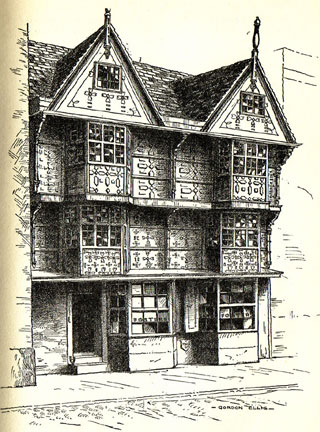‘Syrup and soot’ and ‘essence of old shoes’ were just two of
the names given to coffee by innkeepers and tavern keepers in the 17th
century. Threatened by the craze for coffee drinking, and fearing for their
livelihood, they did everything in their power to close them down. Fortunately
they didn’t succeed and today I am able to pop into my local Costa for a coffee
and chat with friends just as Pepys did in his day.
 |
| Turk's Head, Cambridge coffee house |
What would I find if I went into a coffee house in Pepys’s
time?
Well I’d have to get a man to accompany me, as women weren’t
allowed unless they either owned it or worked there. I’d choose someone like
Isaac Newton to be sure of an interesting conversation! I would look for the
sign of a Turk’s Head, which often denoted a coffee house because of its
Turkish origins.
I would have to pay a penny at the door, which is a fee to say
that I agree to the rules of the house. I would undertake not to gamble, swear,
quarrel, or mourn over lost love. Obviously the ‘mourning over a lost love’
must have been a big problem! Because of this admission charge and the free exchange
of ideas and opinions the coffee houses promoted, in London
they became known as “Penny
Universities
If I inhaled, I might smell the beans roasting, a cause of
great worry to bookseller neighbours in a London
still mostly half-timbered from Elizabethan times. Inside the house the atmosphere
would be acrid and thick with tobacco smoke from innumerable long-stemmed pipes,
not to mention the smoke from the damp sea-coal burning in the grate, and thin
candles or rush-lights giving off their waxy smell. Add to this the unwashed
bodies, delicately perfumed by pomanders, and the tang of perfumed or aromatic
snuff, and I can see where the ‘essence of old shoes’ might have come from!
If I managed to brave the stench, then I might be astounded
by the noise. Of course there was the hubbub of conversation in the background,
interspersed by sneezes from the snuff-takers and the clattering of pots and
pans, but also the turning of papers and broadsheets laid out on a long table
at the side of the room, the hiss and bubble of the boiling coffee and the spit
of the fire. But usually there would be somebody “holding forth”, declaiming on
one subject or another, politics being a favourite. I would find politicians in the Cocoa-Tree in St James’s,
whereas Wills Coffee House in Covent Garden
was favoured by literati such as Dryden and Pope.
 |
| Dryden meets Pope in Wills Coffee House |
In The Gilded Lily
the dangerous rogue-about-town, Jay Whitgift, conducts his business in a London
coffee house called the Pelican where he meets members of the Wits Club, a
group of wealthy courtiers including the Duke of Buckingham and the Earl of
Rochester. The antics of the Wits, or the Merry Gang, forever coloured the
reputation of Charles’s court. The Pelican was based on Wills Coffee House, the
real-life meeting place of the Wits who ‘entertained
one another with their trifling composures…as if the fate of kingdoms depended
on them’ Jonathan Swift
In a 17th century coffee house my coffee would be
bitter, the beans boiled over the fire for days in ten gallon cauldrons, with
the addition of wine, ale, or herbs and spices such as spearmint. I would sip
it from a bowl with no handles. No wonder a “Satyr Against Coffee” (1674) called
it ‘horse-pond liquor, witches tipple out
of dead man’s skulls’ Thank goodness for my latte with a touch of sugar,
and my brownie on the side!
In the Economist, 17th century coffee houses are
described as “the internet in a cup”, and they fulfilled exactly this function.
One of the things I love about going for a coffee is that it is invariably with
friends, and that the conversation and exchange of ideas is as important as the
drink. http://www.economist.com/node/2281736
I blog with Hoydens and Firebrands, where you can find another excellent article about coffee houses by Anita Davison.
I can also recommend:
Life in a 17th
century Coffee Shop by David Brandon
The Lives of the
English Rakes by Fergus Linnane
Restoration London
This post first appeared on the great blog HISTORICAL TAPESTRY, why not pop over there for a look at the excellent range of articles, reviews and giveaways.



















Awesome post... I really like your blog... Thanks for great sharing.
ReplyDeletecommercial coffee machines
This comment has been removed by a blog administrator.
ReplyDelete